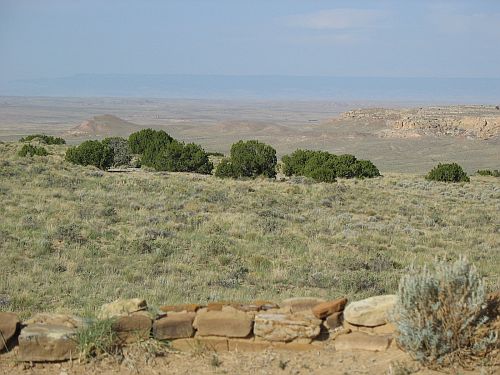
Kin Klizhin
Keith Kloor reports that his piece on Chaco in Archaeology magazine is finally online. (Full disclosure: Keith interviewed me while he was working on the story, although I’m not quoted in it, and he gave me a free copy of the print issue when it first came out.) Unlike most accounts of Chaco, both scholarly and popular, this one focuses on the Navajo traditions about it, which revolve around a legendary villain known as the Great Gambler. There are various versions of the Gambler story, but the basic idea is that the Gambler came to Chaco from the south and challenged the people there to games of chance with increasingly large bets. He won all the games and, since the people ended up betting themselves once they had no possessions left to bet, all the people ended up as his slaves. Once he had them in his control, he forced them to build the great houses of Chaco. The details of the end of the story differ among the various versions, but in all of them the Gambler is overthrown and the people regain their freedom.

Burned Kiva at Pueblo del Arroyo
This is a very negative, sinister view of Chaco, which is considerably at odds with the sunny idea of a peaceful ceremonial center that dominates the park’s interpretive material. Indeed, Chacoan archaeology in general tends to avoid this story, relegating it to irrelevant oral tradition of an unrelated people, if indeed it gets mentioned at all.

Navajo Exhibit at Chaco Visitor Center Museum
There are, however, some archaeologists who take it more seriously. Keith’s article focuses in particular on the idiosyncratic theories of John Stein and Taft Blackhorse, who have for many years been putting forth the controversial argument that the Navajos, rather than being an unrelated people who came into the Southwest centuries after the fall of Chaco, are actually the descendants of the Chacoans, and that the Gambler story is based on the actual history of the Chacoan system, which they have endeavored to confirm through archaeology.

Navajo Hogan at Una Vida
Keith does a good job of presenting this point of view, as well as the typical reaction of mainstream archaeologists, fairly. When he gave me the magazine he expressed some concern that John and Taft would come across as crazy fringe figures in contrast to their sober, scholarly opponents, but I don’t think they seem any crazier than their theories necessarily make them sound. Of course, I’ve been around Chacoan things for so long that I may just be desensitized to how crazy theories about Chaco can sound. In general, Keith’s article is a very good account of the Gambler story, the implications of it for the archaeology of the Southwest, and the problems with it as a basis for understanding that archaeology.

Huerfano Mesa from New Alto
If anyone has been curious about what the name of this blog refers to, reading this article should give some idea. One thing it doesn’t mention, interestingly, is the association of the Gambler with Pueblo Alto, often referred to as “Gambler’s House,” more than with other sites in the canyon. The header image of this blog is a detail of a picture I took at Pueblo Alto.

Corner at Pueblo Alto
I do have a number of criticisms of the piece, but I’m going to leave those for a further post (or perhaps more than one). For now I’ll just recommend it as a very readable and accurate introduction to a number of important issues that rarely get discussed in Southwestern archaeology.

Chuska Mountains from Tsin Kletzin
The idea is idiotic. As are other ideas that have the Navajos coming from the north, but on the west side of the Rockies at this time.
Now, as with the Navajo “appropriating” much of Puebloan religion, it may have a kernel of truth, namely, that at least a fair amount of the ideas that led to the katsina religion came up from Mexico, and this ferment may have been a tipping point for a Chaco already on edge.
Was there possibly actual gambling at Chaco? Yes, and here’s a better Archaeology story from this year. https://www.archaeologicalconservancy.org/when-the-gambler-came-to-chaco/